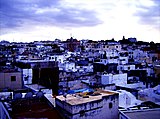
Moulay Ismail Ben Sharif, born around 1645 in Sijilmassa and died on 22 March 1727 at Meknes, was a Sultan of Morocco from 1672–1727, as the second ruler of the Alaouite dynasty. He was the seventh son of Moulay Sharif and was governor of the Kingdom of Fez and the north of Morocco from 1667 until the death of his half-brother, Sultan Moulay Rashid in 1672. He was proclaimed sultan at Fez, but spent several years in conflict with his nephew Moulay Ahmed ben Mehrez, who also claimed the throne, until the latter's death in 1687. Moulay Ismail's 55-year reign is the longest of any sultan of Morocco.

Tangier, also Tangiers is a city in northwestern Morocco. It is on the Maghreb coast at the western entrance to the Strait of Gibraltar, where the Mediterranean Sea meets the Atlantic Ocean off Cape Spartel. The town is the capital of the Tanger-Tetouan-Al Hoceima region, as well as the Tangier-Assilah prefecture of Morocco.
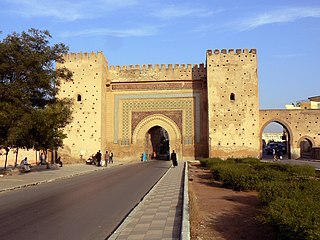
Meknes is one of the four Imperial cities of Morocco, located in northern central Morocco and the sixth largest city by population in the kingdom. Founded in the 11th century by the Almoravids as a military settlement, Meknes became the capital of Morocco under the reign of Sultan Moulay Ismaïl (1672–1727), son of the founder of the Alaouite dynasty. Moulay Ismaïl created a massive imperial palace complex and endowed the city with extensive fortifications and monumental gates. The city recorded a population of 632,079 in the 2014 Moroccan census. It is the seat of Meknès Prefecture and an important economic pole in the region of Fès-Meknès.

Abdelaziz of Morocco, also known as Mulai Abd al-Aziz IV, succeeded his father Hassan I of Morocco as the Sultan of Morocco in 1894 at the age of sixteen. He was a member of the Alaouite dynasty.
MoulayMuhammad ibn Abd al-Rahman, also known as Muhammad IV was the Sultan of Morocco from 1859 to 1873. He was a member of the Alaouite dynasty.
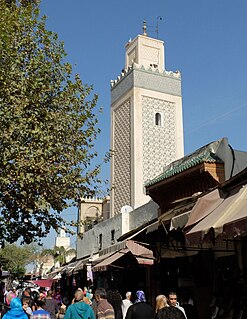
Fes Jdid or Fes el-Jdid is one of the three parts of Fez, Morocco. It was founded by the Marinids in 1276 as an extension of Fes el Bali and as a royal citadel and capital. It is occupied in large part by the historic Royal Palace, which was once the center of government in Morocco and which is still used on occasion by the King of Morocco today. Since 1981 it has been classified, along with Fes el-Bali, as a UNESCO World Heritage Site.

Mechouar or mashwar is a type of location, typically a courtyard within a palace or a public square at the entrance of a palace, in the Maghreb or in historic al-Andalus. It can serve various related functions such as a place of assembly or consultation, an administrative area where the government's affairs are managed, or the place where the sultan historically held audiences, receptions and ceremonies. The name is sometimes also given to a larger area that encompasses the palace, such as the citadel or royal district of a city.
Abu al-Qasim az-Zayyani or, in full, Abu al-Qasim ibn Ahmad ibn Ali ibn Ibrahim az-Zayyani (1734/35–1833) was a Moroccan historian, geographer, poet and statesman from the Berber zayane tribe in Morocco. He undertook diplomatic missions to the Ottoman court and engineered government attempts to bring tribes under central authority. His writings include several historical accounts of the Ottoman and Alaouite dynasties. Az-Zayyani wrote fifteen works in the field of history and geography. Some authors even consider him the greatest historian of Morocco.

Fez or Fes is a city in northern inland Morocco and the capital of the Fès-Meknès administrative region. It is the second largest city in Morocco after Casablanca, with a population of 1.22 million (2020). Located to the northeast of the Atlas Mountains, Fez is situated at a crossroad connecting the important cities of different regions; 206 km (128 mi) from Tangier to the northwest, 246 km (153 mi) from Casablanca, 189 km (117 mi) from Rabat to the west, and 387 km (240 mi) from Marrakesh to the southwest which leads to the Trans-Saharan trade route. It is surrounded by hills and the old city is centered around the Fez River flowing from west to east.
Jaysh al-Rifi was the name of an influential Moroccan army corps in the 17th and 18th centuries. The army was formed by Moulay Ismail out of Berber tribesmen from the eastern Rif. Their rise coincided with the formation of the Black Guard, also by Moulay Ismail. They came to play an important role in the 17th century Moroccan wars against Spanish colonization. Cities like Tangier, Ksar el-Kebir, Mehdya, Asilah were reconquered by the Jaysh al-Rifi. One of its generals was Ahmad al-Rifi, a native of Temsamane, who became governor of Tangier, Asilah and Tetouan. His descendants, the Hamami al-Rifi family, would govern these towns, and most of the Gharb, with a large degree of autonomy until 1912.

Dâr-al-Makhzen is the primary and official residence of the king of Morocco. It is situated in the Touarga commune of Rabat, the national capital. Its official name is the El Mechouar Essaid Palace, which means the venue of happiness palace.

Dar Batḥa, or Qasr al-Batḥa, is a former royal palace in the city of Fez, Morocco. The palace was commissioned by the Alaouite Sultan Hassan I in the late 19th century and finished under his successor Abdelaziz. It was converted into a museum of historical arts and crafts in 1915 with a collection that now comprises over 6,500 objects. The palace is located near Bab Bou Jeloud at the western edge of Fes el-Bali, the old medina quarter of the city, and close to Fes el-Jdid, the new medina quarter.

The Dar al-Makhzen or Royal Palace of Fez is the royal palace of the King of Morocco in the city of Fez, Morocco. Its original foundation dates back to the foundation of Fes el-Jdid, the royal citadel of the Marinid dynasty, in 1276 CE. Most of the palace today dates from the Alaouite era. The vast grounds are home to multiple private structures, patios, and gardens, but historically also included administrative offices and government tribunals. Today, the most publicly visible parts of the palace are its main entrances at the Old Mechouar and the highly ornate 20th-century gates at Place des Alaouites, near the Mellah.
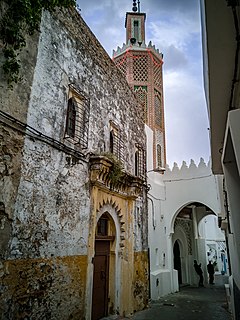
The Kasbah Mosque in Tangier, Morocco, is the main mosque of the historic royal citadel (kasbah) in the old city (medina) of Tangier. It dates to the late 17th century.
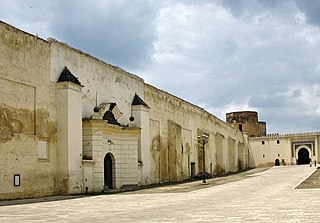
The Dar al-Makina or simply Makina is a former arms factory in Fez, Morocco.

The Barrima Mosque is a mosque in Marrakesh, Morocco, attached to the Kasbah (citadel) and Royal Palace of the city. It was built in the late 18th century by the Alaouite sultan Muhammad ibn Abdallah.

The Kasbah of Marrakesh is a large walled district in the southern part of the medina of Marrakesh, Morocco, which historically served as the citadel (kasbah) and royal palace complex of the city. A large part of the district is still occupied by the official royal palace which serves as the residence of the King of Morocco when visiting the city, while the rest is occupied by other neighbourhoods and monuments.

Dar Moqri is a historic palace or aristocratic house in Fes el-Bali, the old medina of Fes, Morocco. It dates from the 19th-20th century, and was built for the wealthy and powerful Moqri family.
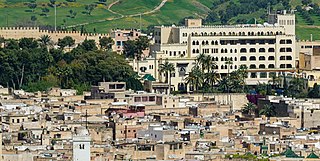
The Jamai Palace, also known as the Dar Jama'i or the Palais Jamaï, is a historic late 19th-century mansion in Fes, Morocco, which was subsequently converted to a luxury hotel. It is near Bab Guissa in Fes el-Bali.

The Kasbah of Moulay Ismail is a vast palace complex and royal kasbah (citadel) built by the Moroccan sultan Moulay Isma'il ibn Sharif in Meknes, Morocco. It is also known, among other names, as the Imperial City or Palaceof Moulay Ismail, or the Kasbah of Meknes. It was built by Moulay Isma'il over the many decades of his reign between 1672 and 1727, when he made Meknes the capital of Morocco, and received occasional additions under later sultans.




















